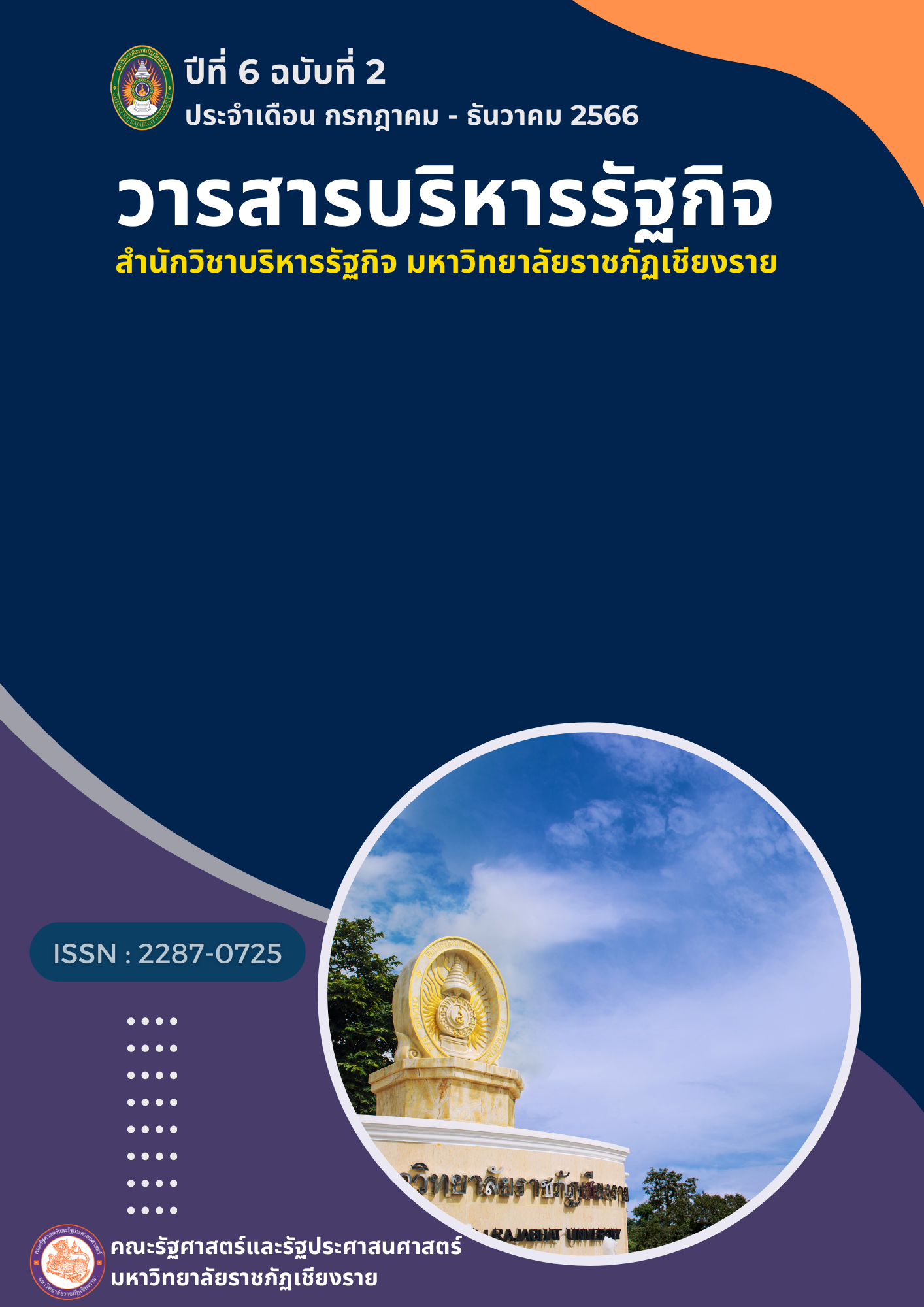Components of Local Economic Capital of Community Enterprises to Upgrade the Local Economy Samut Songkhram Province
Main Article Content
Abstract
The objectives of this article are: To study the composition of local economic capital of community enterprises to upgrade the local economy Samut Songkhram Province. The components come from the study of knowledge, concepts, and related theories from papers and research However, if local economic capital is more independent and capable of initiating activities for local economic development than it is now, local economic development activities will be diversified and consistent with community organizations. Manage and plan your own community development master plan, create community grants or a variety of community funds. It is a guarantee of economic equality and human rights for all types of community businesses, whether they are community enterprises. Community Service Business Community financial institution Emphasis on the principle of participation and distribution of benefits in parallel with the creation of a welfare society created by community members. The community economic welfare system comes from a variety of production bases. It is a holistic aspect of the four factors that respond to the market in the community as the philosophy of sustainable holistic community development. Causing the capital system of communities, enterprises, communities, and financial institutions and the community economy differs from the concept of state community enterprise development and the idea that the community is based on capitalism. Therefore, the authors of the article have synthesized the variables into 4 components as follows: Component 1 Physical Capital Component 2 Financial Asset Capital Component 3 is cultural wisdom capital and Component 4 is human resource capital.
Article Details
References
กิตติศักดิ์ กลิ่นหมื่นไวย. (2561). แนวทางการส่งเสริมการท่องเที่ยวเชิงวัฒนธรรมชุมชนท่ามะโอ อำเภอเมืองจังหวัดลำปาง. วารสารศิลปศาสตร์ มหาวิทยาลัยแม่โจ้, 6(1), 131-148.
กลุ่มส่งเสริมและพัฒนาการท่องเที่ยวชุมชน กองพัฒนาแหล่งท่องเที่ยว. (2562). คู่มือพัฒนาศักยภาพบุคลากรด้านการท่องเที่ยวในชุมชน. กรุงเทพฯ: กลุ่มส่งเสริมและพัฒนาการท่องเที่ยวชุมชน.
คะนอง พิลุน. (2562). การจัดการทรัพยากรธรรมชาติและสิ่งแวดล้อมในท้องถิ่น. มหาสารคาม: วิทยาลัยการเมืองการปกครอง มหาวิทยาลัยมหาสารคาม.
คณะสังคมสงเคราะห์ศาสตร์ มหาวิทยาลัยธรรมศาสตร์. (2560). ชุมชนท้องถิ่นกับการจัดการทรัพยากร. กรุงเทพฯ: มหาวิทยาลัยธรรมศาสตร์.
ฌัชชภัทร พานิช. (2558). ยุทธศาสตร์การจัดการระบบสุขภาพชุมชนอย่างยั่งยืน จังหวัดน่าน. วิทยานิพนธ์ ปรัชญาดุษฎิบัณฑิต สาขาวิชายุทธศาสตร์การพัฒนาภูมิภาค มหาวิทยาลัยราชภัฏเชียงราย.
ฐาปนี เลขาพันธ์. (2557). การจัดการความรู้ด้านสมุนไพร กรณีศึกษา กลุ่มสมุนไพรบ้านดงบัง ตำบลดงขี้เหล็ก อำเภอเมือง จังหวัดปราจีนบุรี. วิทยานิพนธ์ศิลปศาสตรมหาบัณฑิต สาขาวิชานิเทศศาสตร์และสารสนเทศ มหาวิทยาลัยเกษตรศาสตร์.
ธนาคารไทยพาณิชย์, ศูนย์วิจัยเศรษฐกิจและธุรกิจ. (2560). ทำธุรกิจท่องเที่ยวเตรียมรับมือการเปลี่ยนแปลงกับ 3 กระแสแรงแห่งยุค ที่ยากจะต้าน. ค้นเมื่อ 17 เมษายน 2564, จาก https://www.scbeic.com/th
ปริมรัตน์ แขกเพ็ง. (2551). รายงานการศึกษาแนวทางการพัฒนาโครงการสนับสนุนการพัฒนาอุตสาหกรรมชนบท. กรุงเทพมหานคร: สำนักพัฒนาอุตสาหกรรมชุมชนกรมส่งเสริมอุตสาหกรรม.
พิชชา บัวแย้ม, ประสงค์ ตันพิชัย และสันติ ศรีสวนแตง. (2560). การดำรงอยู่ของทุนทางสังคมในชุมชนลุ่มน้ำมูลตอนล่าง: กรณีศึกษาตำบลโพธิ์ศรี อำเภอพิบูลมังสาหาร จังหวัดอุบลราชธานี. Veridian E-Journal, Silpakorn University, 10(2).
พจนา สวนศรี และสมภพ ยี่จอหอ. (2556). คู่มือมาตรฐานการท่องเที่ยวโดยชุมชน. เชียงใหม่ : สถาบันการท่องเที่ยวโดยชุมชน (CBT-I).
มนรัตน์ ใจเอื้อ. (2559). รูปแบบการตลาดเพื่อพัฒนาการท่องเที่ยวเชิงมรดกวัฒนธรรม:ชุมชนบางหลวง ตำบลบางหลวง อำเภอบางเลน จังหวัดนครปฐม. วารสารวิชาการศรีปทุมชลบุรี, 12(3), 12-24.
วราภรณ์ เชื้ออินทร์. (2555). แนวคิดการจัดการการศึกษาหลังปริญญาเพื่อการพัฒนาอย่างยั่งยืน. ศรีนครินทร์เวชสาร, 27(1), 77-93.
ศุภวัฒน์ ปภัสสรากาญจน์. (2558). เอกสารประกอบการสอน รายวิชา การพัฒนาเศรษฐกิจชุมชนตามแนวเศรษฐกิจพอเพียง. กรุงเทพฯ: มหาวิทยาลัยราชภัฏสวนดุสิต.
สำนักพัฒนาแหล่งท่องเที่ยว สำนักงานพัฒนาการท่องเที่ยว กระทรวงการท่องเที่ยวและกีฬา. (2553). คู่มือเครือข่ายการท่องเที่ยวโดยชุมชน พิมพ์ครั้งที่ 4.กรุงเทพฯ: สำนักงานพัฒนาการท่องเที่ยว กระทรวงการท่องเที่ยวและกีฬา.
สุขภาพคนไทย. (2557). ชุมชนท้องถิ่นจัดการตนเอง สู่การปฏิรูปประเทศจากฐานราก. กรุงเทพฯ: สถาบันวิจัยประชากรและสังคม มหาวิทยาลัยมหิดล.
สุดถนอม ตันเจริญ. (2559). การจัดการการท่องเที่ยวโดยชุมชนกับการพัฒนาการท่องเที่ยวอย่างยั่งยืนของชุมชนบางขันแตก จังหวัดสมุทรสงคราม. วารสารวิชาการการท่องเที่ยวไทยนานาชาติ, 13(2), 1-24.
หทัยรัตน์ บุณโยปัษฎัมภ์. (2561). ภูมิปัญญาท้องถิ่นกับการพัฒนา. กรุงเทพฯ: โครงการผลิตหนังสือและตำรา คณะสังคมศาสตร์ มหาวิทยาลัยศรีนครินทรวิโรฒ.
Cai, L. A. (2002). Cooperative branding for rural destination. Annals of Tourism Research, 29(3), 720-742.
Gartner, W. C., & Ruzzier, M. K. (2014). Tourism destination brand equity dimensions: Renewal versus repeat market. Journal of Travel Research, 50(5), 471-481.
Kapferer J.N. (2005). The post-global brand. Journal of Brand Management, 12(5), 319-324.
Keawtep, K. & Hinwiman, S. (2008). Theoreticians in Political Economy and Communication Studies. Bangkok: Bhappim Press.
Porter, M. E. (1990). The Competitive Advantage of Nations. London: Macmillan.
Ritchie, J. R. B., & Crouch, G. I. (2003). The competitive destination: A Sustainable Tourism Perspective. Wallingford, United Kingdom: CABI.


